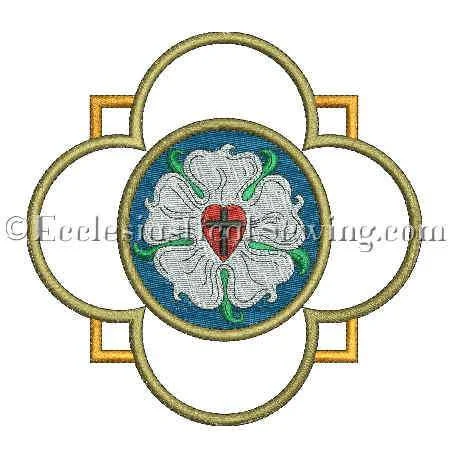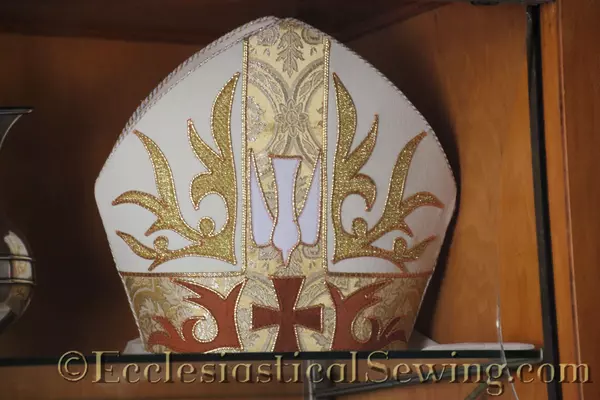The Protestant Reformation And Its Importance To Ecclesiastical Sewing
The Protestant Reformation And Its Importance To Ecclesiastical Sewing
The Protestant Reformation And Its Importance To Ecclesiastical Sewing: Did you know that next fall is going to be a very special year? October 31, 2017, will mark the 500th anniversary of the Reformation. For Protestant churches, this is going to be a joyous celebration. No matter an individual’s adherence to a certain denomination, church history is important to study. It has influenced our past, even if we do not adhere to certain doctrines today. Although protestant churches separated and became many parts, there are still traceable points of similarity amongst many groups; Lutheran churches and the Roman Catholic Church, for instance, have similarities. These points of similarity can be seen in the worship service structure and our favorite topic: ecclesiastical sewing. But more on that later.
1
1Roberts, Carrie. Stole & Chasuble. October 10th, 2016. Personal Collection, Ecclesiastical Sewing, Minnesota.
Martin Luther Historic Act
October 31st, Halloween, was the day that Friar Martin Luther, an Augustinian lecturer at the University of Wittenberg, posted his theses of discussion to the door of the cathedral, which was adjacent to the university. Some historians dispute this story as a piece of Protestant propaganda, although it seems that tradition and most historians say it is factual rather than not. Regardless if he posted this document to the door or not, Luther wrote the theses out of concern. He had been troubled for a long time about certain doctrines. Out of turmoil about his salvation and that of his congregational flock, he studied the Bible and wrote down points to discuss with his fellow scholars.
2
2Roberts, Carrie. Luther Rose In Quatrefoil Frame. October 10th, 2016. Personal Collection, Ecclesiastical Sewing, Minnesota.
Luther’s Path to Reformation
Martin Luther grew up in a strict household. He received a thorough education and was planning to become a doctor of the law. Instead, he joined an Augustinian order of brothers. He did everything that was prescribed to ensure his eternal salvation. And still, he had doubts. Luther said that if ever a man got to heaven through being a monk, it would have been him. Still, he was in mental anguish as to the surety of his eternal status. Once he became a priest and then a lecturer at the University of Wittenberg, he took up these issues with his peers. What he set out to do was not to break apart the established church. Instead, he merely wanted other bright minds to help him address these issues; this is not odd because many theologians, since the early church, were always discussing doctrine. What this turned into was a breaking away from the main body of the Roman Catholic Church. Eventually, Luther realized that the church’s doctrines needed a kind of reform. From this stance, many Protestants followed his example. Other groups went further than his stance.
Luther was not the first to make a stand, but he was a success. Before Luther, there were theologians such as John Wycliffe and John Hus–interesting men to read about! It was after Luther that the Protestant fire became uncontrolled.
Changing Church Ritual
For some, church rituals changed drastically. Bradford Smith–who wrote about William Bradford of Plymouth, one of the original pilgrims–said that Puritanism, amongst other things, sought to simplify ritual in the church. The French Huguenots in 1568 and again in 1581 were reprimanded for dressing extravagantly. And so we can see where certain churches and denominations today have their ministers dress in ordinary clothes–either business wear or casual.
Some churches went away from the outward beauty of a church service while trying to find some pure inner beauty. In recent years, some bodies of churches–influenced by Calvinism–are “tardily making amends for [their] unfortunate suppression of arts as an aid in worship. The Lutheran Church, by contrast, has no need to change its practice because it has continued to employ the arts in its ceremonies of worship from the time of its inception….”3 Lutheran churches have beautiful altar coverings, both linens and brocade frontals. The pulpits are decorated by intricately embroidered pulpit falls and the walls are decorated with tapestries. The Lutheran pastor wears a clerical collar and for worship service, he wears a cassock alb, a stole, and often a chasuble in-between. There are even some Lutheran ministers, who wear miters.
4
3Leslie Spelman, “Luther and the Arts.” The Journal of Aesthetics and Art Criticism Vol. 10, No. 2 (1951): 75.
4Roberts, Carrie. Mitre. October 10th, 2016. Personal Collection, Ecclesiastical Sewing, Minnesota.
Preserving Tradition Through Ecclesiastical Vestments Across Denominations
And so, even though the churches split away, church art was not lost. Although they do not agree on certain doctrines, they still keep many of the same traditions and that includes ecclesiastical vestments. This is why at Ecclesiastical Sewing, we are working so hard to provide liturgical vestments and vestures to all denominations that want and need them. The study of church history is crucial to understanding similarities and differences. Sewing ecclesiastical pieces is an art form; those who dedicate their sewing to the church do it to glorify God, the One who created art and gave us the ability to craft it. Thank you for reading and happy Reformation Day.
~Nihil Sine Deo~
Be sure to visit our online store front Ecclesiastical Sewing where you may shop for Liturgical Fabrics, altar linen fabrics, church vestment-making patterns, liturgical machine embroidery designs, church vestment trims and notions and so much more. You may also find us on Ecclesiastical Sewing on Facebook, Twitter, and Pinterest.
Bainton, Roland. Here I Stand A Life of Martin Luther. Nashville: Abingdon Press, 1978.
Maxwell, Richard. Pilgrim and Puritan: A Delicate Distinction. Pilgrim Society Note, 2003.
Posset, Franz. The Real Luther. Saint Louis: Concordia Publishing House, 2011.
Spelman, Leslie. “Luther and the Arts.” The Journal of Aesthetics and Art Criticism Vol. 10, No. 2 (1951): 10.2307/426851
Spitz, Lewis. The Protestant Reformation. Saint Louis: Concordia Publishing House, 1985.
Reformation 2018 – 501 Years in the Making
The Protestant Reformation And Its Importance To Ecclesiastical Sewing
Luther Rose Liturgical Brocade Church Vestment Fabric
October 11th–Philip the Deacon
In Honor of the 500th Anniversary of the Reformation
December 20th: Katie Luther
The Rose of the Lutherans
Chi Rho Liturgical Machine Embroidery Design
Religious Lutheran Machine Embroidery Designs for Church Vestments
Meet Martin the Steadfast









 RSS - Posts
RSS - Posts
You must be logged in to post a comment.